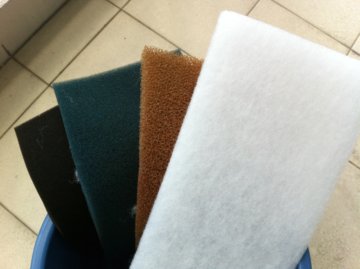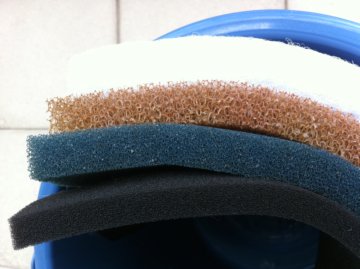|
White, green, blue and black sponges, rings, beads, what are all these filter media about anyway??
Know your aquarium filter media and you are more than half on your way to keeping your fish happy. Thats right, its half of your filtration battle, and its always a battle. When I was a kid, I started with those filters that were inside fish tanks. I would follow what my dad did, which was fill it with aquarium gravel at the bottom, may be some aquarium sand and closed the top off with some white sponge. Depending on the type of filter, I may put this combination the other way around. Either way, I had no idea what was going on in the filter, all I knew was that the fish were generally healthy and ever so often I would change the white sponge with a new one, since its all green or brown, full of fish waste. Later on, I started to use those filters that were outside fish tanks. These seemed quite cool, especially the ones that look like a waterfall. The same principles held as well with some designs changing over time. Still I did not know why this filter media combination worked but that it did. It was only later on in life, when I wanted to setup a fish pond inside my place (as opposed to outside in the natural elements) that I truly understood or better understood the various filter media and what to do with them. (This was because I learned it the hard way, I had 3 mass fish die-offs before I figured it out! :| ) It basically dawned on me, that for more than 20 years, my filtration methodology was a huge fluke! :) I was just lucky that I got things right. The main reason we need aquarium filter media is to remove the various toxins that arise in your fish tank because... well... you have fish in them! :) I know you are going, okay you think I am an idiot right? Well no, thats not my intention. What my intention was, was to make quite a simple point that even though you and me have a designated place to 'relieve' ourselves (a.k.a. the toilet), fish do not have such luxuries. In fact fish literally 'swim' in their toilet as they do not only excrete randomly (as I am sure you would have noticed) but they also excrete through their skin, waste in the form of ammonia (which is quite impossible for you to notice since you cant see it). Now Ammonia, is that stuff you likely have smelt at your office or at school or maybe even at home when someone mops the floor. So can you imagine living with ammonia all around you? Dont mention the smell, the toxicity is probably crazy enough for you, so think of what it does to fish! Anyway, ammonia degrades naturally to nitrites which in turn to the least harmful nitrates. This is the basic idea of something called the Nitrogen Cycle. The thing is, this cycle requires both aerobic and anaerobic bacteria. Basically aerobic bacteria needs oxygen while anaerobic bacteria does not need oxygen. Having a good combination of these in your fish tank, along with reducing the number of bad bacteria, is the key to good fish health. So where does aquarium filter media fit in all of this you say? Well, firstly, there is a dizzying array and types. There are white sponges, blue ones, orange-red ones, green ones, black ones and there are small sizes, large sizes, and there are rectangular ones, oval ones. So whats the deal right?
The shape is not rocket science, that depends on the type of filter you have. It has to fit in the filter so it has to be the same shape. Easy. Now the various colors are not as easy. No matter the color though, the most important thing is the texture. Usually the white ones tend to be closely packed sponges, sometimes called filter wool and they do have the consistency of packed wool. The ones in various colors will generally differ in the size of 'holes' you see in them. There will be ones with big holes and small holes and even smaller holes. These types will tend to be more expensive.
So its not about making sure your filter media has some sort of color coordination. Although, on some level it does give you some appeal (only for a very short while since it will get full of fish waste). What it IS about, is arranging this filter media in a way that will make filtration most optimal. Now, I am sure there are various theories out there on what is optimal. My theory is quite simple, its thinking about the nitrogen cycle I mentioned earlier as well as putting cost as a factor. what I do is, I layer my filter media in my filter in the following way (note this is an external overhead filter where the fish water flows on to the first layer mentioned below, and after going through the layers, exits downwards): 1. white sponge on top 2. orange-red sponge with big holes below point 1. 3. blue sponge with smaller holes than point 2, below point 2. 4. black sponge with even smaller holes than point 3, below point 3. Why do I do it this way? well firstly, point 1 will ensure that all the big 'crap', excuse my French, gets caught first. An important point here is that it means I will need to change this white sponge regularly (throw it away basically) and since its the least expensive of the lot, it makes most economic sense. Secondly, points 2-4 are the simple idea that aerobic or oxygen needing bacteria, will have oxygen being in the upper layers of the stack (bigger holes therefore more air) while anaerobic bacteria can thrive in the lower layers where there will be less oxygen, not just because of the smaller holes (and therefore less air trapped) but also because of the stacking and the constant water flowing covering the filter media. So there you go, thats my ideal aquarium filter media stacking for an overhead filtration system. And I tell you it works because of testing with my water testing kit as well as understanding that regular fish water changes are needed to complement. Not to mention, frequent changing of the white sponges is also required and from time to time cleaning of the sponges in points 2-4. The reason for frequent changing of the white sponge is that well firstly over time they will be laden with fish doodoo so they will become less effective. Secondly when they become less effective, the water will start to flow in a way that bypasses the white layer and so hits the layers below. What happens then is the accumulation of visible fish waste going to the wrong layer and very quickly you will start to get bad bacteria that likes this situation. When that happens, its likely you will notice your fish being sick before you realize what had happened. So keep tabs on this! Cleaning the other layers, does not mean you should take it out and rinse it with tap water! BIG NO-NO. If tap water contains Chlorine, and they generally do anywhere, this will kill the good bacteria you have so painstakingly nurtured. Always use the same aquarium water to wash down the filter media. This will ensure good health of good bacteria that are in the filter media. Now the rings and beads and ball like thingies that you may see in pet shops are not really there to trap fish waste. Although they could. Their purpose is really to provide a large surface area for good bacteria to hang on to and help out with the nitrogen cycle in the water. Sometimes these are placed in the filters, some other times you can see them in the fish tank or pond itself. Works fine either way. At the same time, because there are plenty of shapes among the rings and beads, this helps to swirl the water around a little bit to again maximize the amount of filtration that happens. There are plenty of other extra materials that can help in maintaining water quality, like zeolite, activated carbon, coral and many other things as well. In summary then, you should ensure the following: a) Have the logical layering of filter media setup b) Replace the top most filter media regularly (assuming water flow is from top) c) Consistent checking of lower level filter media d) Rinsing down of filter media using the same fish water from time to time e) Addition of other beneficial filter media inside the filter or inside the fish tank f) A good understanding of the fish tank to know when water changes should be done and done regularly (change of half of the fish tank water is good enough)
|







